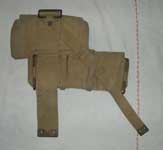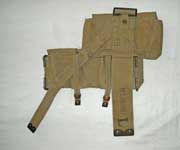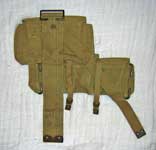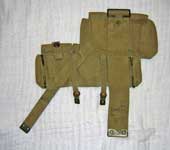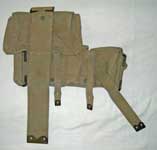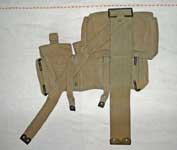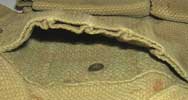W.E. Patt. '08 Equipment Carriers
Carriers, cartridge - General
Introduced with the W.E. Patt. '08 by List of Changes L. of C. §14288, dated 31st January 1908, the Carrier, cartridge, 75 rounds, left, and Carrier, cartridge, 75 rounds, right, were mirror images of one another. Each consisted of an assemblage of 5 cartridge pockets, arranged in two rows with three pockets in the bottom row and two in the top. Extension tabs have now been added, behind each Carrier, giving four “ends” on each side of the wearer. This was due to the later introduction of a Carrier for the Head of the Sirhind entrenching tool, which was to be worn on the right, behind the Water bottle carrier.
The flaps were no longer integrally woven; instead a flap was stitched into each pocket. Each pocket held up to three 5 round chargers of .303-inch ammunition, with the flaps fitted with the crown (female) half of a press fastener. Two spigot (male) halves of the fastener, one above the other, allowed for closure over a full or part-empty pocket. Using the unique Mills webbing looms, each row of pockets was woven integrally, in a tapered form, which even included internal dividers - simultaneously woven - to separate the chargers. They are incredible examples of how Anson Mills’ ideas were developed. Originally, even the flaps were woven in the same operation, but were later attached separately. Each Carrier was connected to the Waist belt by two 3-inch double brass hooks and two narrow straps. A 2-inch strap, acting as the chape for a 2 inch Brace buckle, was extended vertically behind the two top pockets of the Carrier. The Brace was fed through the 2-inch Twigg buckle at the top of this strap and passed behind the Carrier. Each Carrier also had a 1-inch Diagonal Strap that extended at a 45° angle from the rear corner of the lower row of pockets. This strap was used to support the Pack, or Haversack, when these items were carried on the back.
Carriers, cartridge, 60 rounds, Trials Pattern
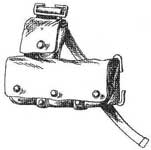 Mills’ Patent 28,812 / 1906 actually shows Cartridge Carriers with only four pockets, for 60 rounds. i.e. 120 rounds in total. Major Burrowes’ regiment, the 87th Royal Irish Fusiliers, published an article in Faugh-a-Ballagh, their Regimental Gazette. It quotes “…The original design…carried only 120 rounds…but soon another pocket was added…on the top row…”1. From this it can safely be assumed that Mills actually manufactured this form. What is not stated, but is clearly shown in the Patent, is that the lower tier of pockets was covered by a single flap, secured by three press fasteners. Earlier Mills designs of Cartridge Carriers (e.g. Wise-Twigg Equipment) had exactly this form, as the flap was integrally woven with the backing-piece of the Carrier.
Mills’ Patent 28,812 / 1906 actually shows Cartridge Carriers with only four pockets, for 60 rounds. i.e. 120 rounds in total. Major Burrowes’ regiment, the 87th Royal Irish Fusiliers, published an article in Faugh-a-Ballagh, their Regimental Gazette. It quotes “…The original design…carried only 120 rounds…but soon another pocket was added…on the top row…”1. From this it can safely be assumed that Mills actually manufactured this form. What is not stated, but is clearly shown in the Patent, is that the lower tier of pockets was covered by a single flap, secured by three press fasteners. Earlier Mills designs of Cartridge Carriers (e.g. Wise-Twigg Equipment) had exactly this form, as the flap was integrally woven with the backing-piece of the Carrier.
Carriers, cartridge, 75 rounds, Trials Pattern
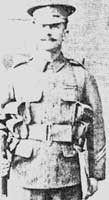 The later five pocket Trials Carrier, with two pockets on its top tier, had these covered by a single flap too, which is secured by two press fasteners. The Brace buckle and its extension strap remain behind the innermost lower pocket, but the two top pockets have had to be re-aligned centrally across the centreline of the Brace. This caused the inner top pocket to overhang the inner lower pocket. This characteristic arrangement, repeated in the productionised design, is almost invariably drawn incorrectly by many illustrators, both at the time and still today. Note that the Carrier buckles are on short chapes; there being no extension tabs behind the Carrier. The four Brace ends were sufficient to carry the Water bottle carrier and Haversack.
The later five pocket Trials Carrier, with two pockets on its top tier, had these covered by a single flap too, which is secured by two press fasteners. The Brace buckle and its extension strap remain behind the innermost lower pocket, but the two top pockets have had to be re-aligned centrally across the centreline of the Brace. This caused the inner top pocket to overhang the inner lower pocket. This characteristic arrangement, repeated in the productionised design, is almost invariably drawn incorrectly by many illustrators, both at the time and still today. Note that the Carrier buckles are on short chapes; there being no extension tabs behind the Carrier. The four Brace ends were sufficient to carry the Water bottle carrier and Haversack.
Carriers, cartridge, 75 rounds (1st Issue)
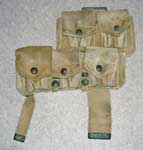
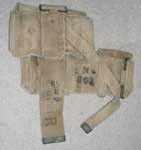 No discrete nomenclature distinguishes these, which must therefore be termed 1st Issue. These had straight, crimped brass tips on the tabs. This right Carrier is maker marked "M.W. & S. Ltd." and dated 1909. From the Richard Marshall Collection, photos © Richard Marshall 2011.
No discrete nomenclature distinguishes these, which must therefore be termed 1st Issue. These had straight, crimped brass tips on the tabs. This right Carrier is maker marked "M.W. & S. Ltd." and dated 1909. From the Richard Marshall Collection, photos © Richard Marshall 2011.
Carriers, cartridge, 75 rounds (2nd Issue)
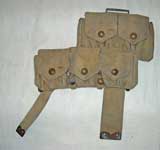
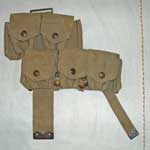 Again the Army gave no discrete nomenclature, much to the frustration of collectors. The collectors’ term is therefore 2nd Issue. List of Changes L. of C. §15048, dated 22nd November 1909, mad a number of minor modifications to various items of W.E. Patt. '08. One of these was to replace the crimped brass tips on all straps and tabs with eyeletted ones. This was the only modification made to the Cartridge carriers by this L. of C. Entry. These Carriers, cartridge, 75 rounds incorporate this modification. This pair is maker marked "M.E. Co." and dated 1911. From the Karkee Web Collection.
Again the Army gave no discrete nomenclature, much to the frustration of collectors. The collectors’ term is therefore 2nd Issue. List of Changes L. of C. §15048, dated 22nd November 1909, mad a number of minor modifications to various items of W.E. Patt. '08. One of these was to replace the crimped brass tips on all straps and tabs with eyeletted ones. This was the only modification made to the Cartridge carriers by this L. of C. Entry. These Carriers, cartridge, 75 rounds incorporate this modification. This pair is maker marked "M.E. Co." and dated 1911. From the Karkee Web Collection.
The rear view of the same pair of Carriers. Note the diagonal strap, which was the key feature of Burrowes’ alleged design. The weight of the Pack, attached to this strap, is transferred as a downward force – but to the front of the Brace. As flat-loop belting had yet to be developed, the “C” clips of the Carrier could move. The weight of a fully loaded Carrier would cause it to sag, pulling the ends inwards. The two narrow straps ensured that the Carrier could not sag outwards.
Carriers, cartridge, 75 rounds, left, Mark II (3rd Issue)
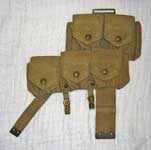
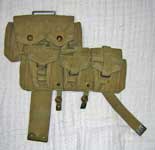 It is not uncommon for new items of accoutrements to be introduced without a Mark No. This, the 3rd Issue, though only of the left Carrier, was changed in Function, the Form and Fit remaining unchanged. Accordingly they were officially termed Mark II, though no earlier carrier was called Mark I. They are the 3rd Issue and final productionised standard. Shortly after the start of the Great War, the Mills Equipment Company received an urgent complaint from the War Office. There was a problem with the left Cartridge carrier of the Web Equipment, Pattern 1908. The lower flap covers on the cartridge pockets were coming open in action. According to Military Headquarters in France, when a soldier leaned up against a parapet, for example, to take aim, the pockets would open and the chargers inside would fall out. KW Contributor Andrew Upton has located corroboration of this claim in the War Diary of the 2nd Battalion Seaforth Highlanders. In the notes for the entry of 30th September, 1914 (p. 39): "(i) Pouches of Equipment - after some wear these are difficult to close, & remain constantly open - much ammunition was lost by this."
It is not uncommon for new items of accoutrements to be introduced without a Mark No. This, the 3rd Issue, though only of the left Carrier, was changed in Function, the Form and Fit remaining unchanged. Accordingly they were officially termed Mark II, though no earlier carrier was called Mark I. They are the 3rd Issue and final productionised standard. Shortly after the start of the Great War, the Mills Equipment Company received an urgent complaint from the War Office. There was a problem with the left Cartridge carrier of the Web Equipment, Pattern 1908. The lower flap covers on the cartridge pockets were coming open in action. According to Military Headquarters in France, when a soldier leaned up against a parapet, for example, to take aim, the pockets would open and the chargers inside would fall out. KW Contributor Andrew Upton has located corroboration of this claim in the War Diary of the 2nd Battalion Seaforth Highlanders. In the notes for the entry of 30th September, 1914 (p. 39): "(i) Pouches of Equipment - after some wear these are difficult to close, & remain constantly open - much ammunition was lost by this."
As Albert Lethern tells the story in the Mills Golden Jubilee book, he was informed of this problem in the afternoon. Immediately he and his design team developed a fix that involved adding a short strap restrained by a loop, This allowed the lower three pocket to be opened enough to get access to the chargers, but not wide enough for them to fall out unaided. The next morning Mr. Wise demonstrated the "fix" at the War Office by "walking on his hands" across the room wearing a full set of W.E. Patt. '08, with the revised pockets full of ammunition and the fasteners opened. Mr. Wise seems to have enjoyed this particular party trick; he used the same demonstration in his pre-war sales pitch to the Canadian authorities. The modification was judged acceptable, and was entered into the List of Changes with L. of C. §16979, dated 17th October 1914. It's worth noting that on the left Cartridge carrier was modified and designated as the Mark II; the right Carrier was unchanged. In those far-off days "left handers" were not tolerated in the Army. Lord Kitchener himself had requested that "left handed" S.M.L.E.'s be produced when the new rifle was introduced in 1903; his request was denied. This pair is maker marked "M.E. Co." and dated 1917.
The rear view of the same pair of Carriers. From the Karkee Web Collection.
Carriers, cartridge, 75 rounds (4th, or "Economy" Issue)
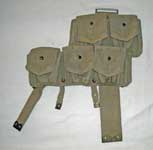
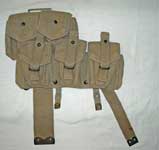
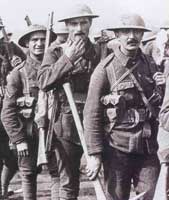 No official nomenclature is positively known, but a spare “candidate” is Carriers, cartridge, 75 rounds, experimental. It is, in collectors’ terms, the 4th Issue of Carriers. In this variation the snap fastener spigots have been replaced by simple brass studs, and the fastener crowns by "buttonholes". We haven't yet found any official documentation authorising this change, but it must exist. Other than this economy measure, these Cartridge carriers are constructed in the normal fashion. Neither Carrier in this pair has any readable markings. We are unsure as to exactly when this modification was introduced, and have read reports of this type of Carrier dated as early as 1915. KW haven't been able to confirm this date. The picture at right is the earliest dated one we've found, and is marked "October 1916". Any assistance is appreciated, as usual.
No official nomenclature is positively known, but a spare “candidate” is Carriers, cartridge, 75 rounds, experimental. It is, in collectors’ terms, the 4th Issue of Carriers. In this variation the snap fastener spigots have been replaced by simple brass studs, and the fastener crowns by "buttonholes". We haven't yet found any official documentation authorising this change, but it must exist. Other than this economy measure, these Cartridge carriers are constructed in the normal fashion. Neither Carrier in this pair has any readable markings. We are unsure as to exactly when this modification was introduced, and have read reports of this type of Carrier dated as early as 1915. KW haven't been able to confirm this date. The picture at right is the earliest dated one we've found, and is marked "October 1916". Any assistance is appreciated, as usual.
The rear view of the same pair of Carriers. From the Karkee Web Collection.
Carriers, cartridge, 75 rounds, left, Mark II (3rd issue, modified)
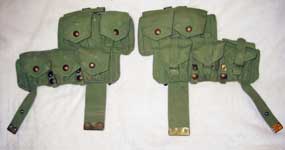
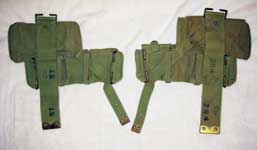 This pair of Cartridge carriers is identical to other 3rd issue Carriers, with the addition of a small grommeted hole on the 1-inch rear angled strap. No documentation has yet been found to support this variation, but this is not a one-off; Carriers with this feature are encountered from time to time. Best guess right now is that it was a unit level modification, perhaps post-war, done to allow Patt. '14 Packs to be used with W.E. Patt. '08. This pair is maker marked "M.E. Co.," but the dates are indistinct. The 'CH' marking stamped on each carrier is the property mark for the Royal Marines Chatham garrison. From the Mark Palmer Collection. Photos © Mark Palmer 2017.
This pair of Cartridge carriers is identical to other 3rd issue Carriers, with the addition of a small grommeted hole on the 1-inch rear angled strap. No documentation has yet been found to support this variation, but this is not a one-off; Carriers with this feature are encountered from time to time. Best guess right now is that it was a unit level modification, perhaps post-war, done to allow Patt. '14 Packs to be used with W.E. Patt. '08. This pair is maker marked "M.E. Co.," but the dates are indistinct. The 'CH' marking stamped on each carrier is the property mark for the Royal Marines Chatham garrison. From the Mark Palmer Collection. Photos © Mark Palmer 2017.
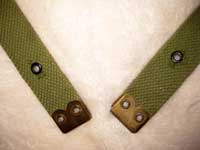
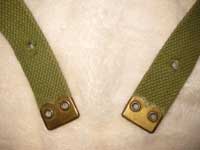 Details of the grommets in the 1-inch angled straps: (far left) front; (near left) rear.
Details of the grommets in the 1-inch angled straps: (far left) front; (near left) rear.
Carriers, cartridge - Special Empire Designs
The Cartridge carriers described above were the issue for the British Army and many other countries within the Empire. However, some countries were still armed with the older (Long) Magazine Lee Enfield, rather than the Short, Magazine Lee Enfield, on which the U.K. had standardised in 1902. The S.M.L.E. introduced the concept of charger-loading, which the M.L.E. did not have at that time. M.E.Co. were now well-placed to cater to different demands – you wanted it, Mills could weave it! Canada was the first to have its own variant of Patt. ’08, as they had standardised on a different rifle altogether.
Carriers, cartridge, Canadian issue
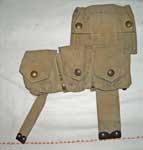
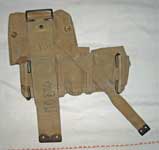 The W.E. Patt. '08 Cartridge carrier was designed to carry .303-inch ammunition in the 5 round chargers used by the Short, Magazine Lee-Enfield Rifle. Although the older "Long Lee" Magazine Lee-Enfields and Lee-Metfords were still widely in service, by 1908 the SMLE was main battle rifle for regular British and Empire forces everywhere, except The Dominion of Canada. There, the home-grown Ross Rifle Mk. II was the official issue. Designed by Sir Charles Ross and manufactured at the Ross Rifle Company in Quebec, the Ross Rifle Mk. II did not use chargers, but was instead loaded with single cartridges. In order to sell W.E., Patt. '08 to Canada, M.E. Co. had to re-design the Cartridge carriers. Cartridges for the Ross were packaged in 10 round paper packets. The new design had three pockets, of box and not tapered form, on the bottom, each of which could carry two 10 round packets, and a single pocket on the top. The top pocket carried a single 10 round packet and 5 individual rounds, which fit into smaller pockets woven into the inside of the top cartridge pocket. The Canadian version of Web Equipment. Pattern 1908, including the modified Cartridge carriers, was entered in the Canadian List of Changes by C.L.C. entry 447, dated 1st September 1910, which did not include “75 rounds” in the nomenclature. The example shown here is a right Carrier. The original markings have been obliterated by time and use, but this type was made only by the Mills Equipment Co. As for a date, the Canadian List of Changes entry was in 1910. The latest marked date reported to Karkee Web for one of these Carriers is 1914. Canadian Patt. '08 was augmented by Canadian W.E., Patt. '13 in 1913-14, so it would make sense that this Carrier was discontinued about then. From the Karkee Web Collection.
The W.E. Patt. '08 Cartridge carrier was designed to carry .303-inch ammunition in the 5 round chargers used by the Short, Magazine Lee-Enfield Rifle. Although the older "Long Lee" Magazine Lee-Enfields and Lee-Metfords were still widely in service, by 1908 the SMLE was main battle rifle for regular British and Empire forces everywhere, except The Dominion of Canada. There, the home-grown Ross Rifle Mk. II was the official issue. Designed by Sir Charles Ross and manufactured at the Ross Rifle Company in Quebec, the Ross Rifle Mk. II did not use chargers, but was instead loaded with single cartridges. In order to sell W.E., Patt. '08 to Canada, M.E. Co. had to re-design the Cartridge carriers. Cartridges for the Ross were packaged in 10 round paper packets. The new design had three pockets, of box and not tapered form, on the bottom, each of which could carry two 10 round packets, and a single pocket on the top. The top pocket carried a single 10 round packet and 5 individual rounds, which fit into smaller pockets woven into the inside of the top cartridge pocket. The Canadian version of Web Equipment. Pattern 1908, including the modified Cartridge carriers, was entered in the Canadian List of Changes by C.L.C. entry 447, dated 1st September 1910, which did not include “75 rounds” in the nomenclature. The example shown here is a right Carrier. The original markings have been obliterated by time and use, but this type was made only by the Mills Equipment Co. As for a date, the Canadian List of Changes entry was in 1910. The latest marked date reported to Karkee Web for one of these Carriers is 1914. Canadian Patt. '08 was augmented by Canadian W.E., Patt. '13 in 1913-14, so it would make sense that this Carrier was discontinued about then. From the Karkee Web Collection.
This detail shows the inside of the top cartridge pocket. You can see the five single round pockets.
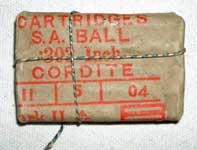 A 10 round paper packet of .303-inch SAA cartridges, typical of the type used with this Carrier. This example contains ten Mk. II cartridges manufactured in Canada at the Dominion Arsenal in 1904.
A 10 round paper packet of .303-inch SAA cartridges, typical of the type used with this Carrier. This example contains ten Mk. II cartridges manufactured in Canada at the Dominion Arsenal in 1904.
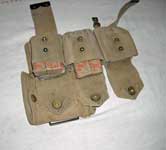
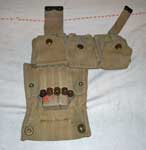 Each of the three lower pockets was designed to hold two 10 round packets, as seen in the picture far left. Near left, the upper pocket holds one 10 round packet and five loose rounds. The loose cartridges shown here are all Mk. VI rounds manufactured in Canada at the Dominion Arsenal, variously dated between 1905 and 1912.
Each of the three lower pockets was designed to hold two 10 round packets, as seen in the picture far left. Near left, the upper pocket holds one 10 round packet and five loose rounds. The loose cartridges shown here are all Mk. VI rounds manufactured in Canada at the Dominion Arsenal, variously dated between 1905 and 1912.
 Another pair of Canadian issue Cartridge carriers, this time both the left and right Carriers are shown. From the Ross Torrington collection, photo © Ross Torrington 2009.
Another pair of Canadian issue Cartridge carriers, this time both the left and right Carriers are shown. From the Ross Torrington collection, photo © Ross Torrington 2009.
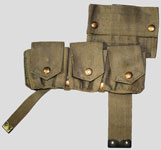
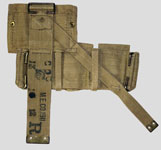
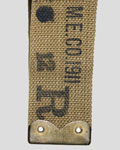 Another Canadian issue right Cartridge carrier. This beautifully preserved example is maker marked "M.E. Co." and dated 1911. From the Michel Perrier Collection, photos © Michel Perrier 2012.
Another Canadian issue right Cartridge carrier. This beautifully preserved example is maker marked "M.E. Co." and dated 1911. From the Michel Perrier Collection, photos © Michel Perrier 2012.
Carriers, cartridge, New Zealand Pattern 1911
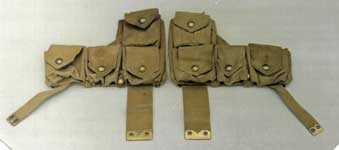 These Carriers, cartridge, are part of the Web Equipment, New Zealand Pattern 1911. This variation of W.E. Patt. '08 was the solution to a problem similar to the one faced by Canada in 1910. By 1911, New Zealand's mounted troops, and some other units, had been supplied with the new Short, Magazine Lee-Enfield rifle, but the Infantry was still using the older Magazine Lee-Enfield. Like the Ross, the M.L.E. was not charger loaded, and the new equipment's Cartridge carriers had to be capable of carrying both single rounds and 10 round paper packets. Not surprisingly, the new Carrier refines the Canadian design. Note that the upper pocket is now the same size as the lower ones, although it still holds just as much ammunition as does much larger top pocket of the Canadian Pattern 1908 Carrier shown just above. The Kiwi version holds two 10 round paper packets in each of its three lower pockets, and one 10 round packet and five loose rounds in its upper, a total of 75 rounds per Carrier.
These Carriers, cartridge, are part of the Web Equipment, New Zealand Pattern 1911. This variation of W.E. Patt. '08 was the solution to a problem similar to the one faced by Canada in 1910. By 1911, New Zealand's mounted troops, and some other units, had been supplied with the new Short, Magazine Lee-Enfield rifle, but the Infantry was still using the older Magazine Lee-Enfield. Like the Ross, the M.L.E. was not charger loaded, and the new equipment's Cartridge carriers had to be capable of carrying both single rounds and 10 round paper packets. Not surprisingly, the new Carrier refines the Canadian design. Note that the upper pocket is now the same size as the lower ones, although it still holds just as much ammunition as does much larger top pocket of the Canadian Pattern 1908 Carrier shown just above. The Kiwi version holds two 10 round paper packets in each of its three lower pockets, and one 10 round packet and five loose rounds in its upper, a total of 75 rounds per Carrier.
According to the information we've gleaned from THE book on New Zealand accoutrements, Barry and Matthew O'Sullivan's New Zealand Army Personal Equipment 1910 - 19452, New Zealand did not have a List of Changes as such. The equivalent seems to have been the Appendix to the Journal of the House of Representatives, Section H19, Annual Report of the General Officers commanding New Zealand Military Forces, mercifully abbreviated by Barry O'Sullivan as AJHR. This was supplemented by Army Regulations, Army Circulars, etc.
Based on the above, the introduction of Web Equipment, New Zealand Pattern 1911 seems to have been in AJHR 1911, section H19 for the period ending 27 July 1911. N.Z.A.P.E. 1910 - 1945 also includes the text of Army Circular Memo No. 3/12, dated 6 February 1912, which details the specifics of supply for the initial distribution of W.E. Patt. '11.3
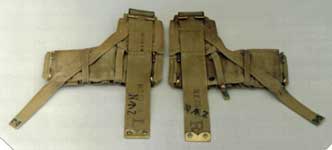 The rear view of the same pair of Carriers. This pair is maker marked "M.E. Co." and dated 1914, which indicates that these Carriers were part of the final shipment of 4,000 sets of W.E. Patt. '11 delivered to New Zealand, in 1914. Photographs © J. Bodsworth, 1988.
The rear view of the same pair of Carriers. This pair is maker marked "M.E. Co." and dated 1914, which indicates that these Carriers were part of the final shipment of 4,000 sets of W.E. Patt. '11 delivered to New Zealand, in 1914. Photographs © J. Bodsworth, 1988.
Carriers, cartridge, 45 rounds, India Pattern

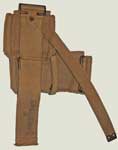 This is an interesting three pocket variation of the Cartridge carrier. However, the nomenclature is not supported by any known documentation. The suffixed “Indian Pattern”, often abbreviated as “I.P.” was a common with various items of military materiel, not just accoutrements. They were not used by the British Army, so would not be found in U.K. Priced Vocabularies. Photographic evidence shows it in use with Indian Army troops, so the additional term is reasonable.
This is an interesting three pocket variation of the Cartridge carrier. However, the nomenclature is not supported by any known documentation. The suffixed “Indian Pattern”, often abbreviated as “I.P.” was a common with various items of military materiel, not just accoutrements. They were not used by the British Army, so would not be found in U.K. Priced Vocabularies. Photographic evidence shows it in use with Indian Army troops, so the additional term is reasonable.
We've been told that this type was possibly used by the Indian Police. Since the Indian Army ownership mark was a Broad Arrow over “I”, the change to a “B”, we believe, must indicate use by Burma, which separated from India proper in 1937. The Carrier is maker marked "M.W.& S. Ltd." and dated 1939. The reasons for yet another variant being made by M.W.& S (no M.E.Co. manufacture has been noted) are not known. A reasonable supposition would concern the physique of Indian soldiers – largely smaller than the average British soldier. Full sized Cartridge carriers would swamp many Indian wearers, even to overlapping the back buckles, which would mis-position the diagonal straps for supporting the Great coat carrier. This is another area that would warrant further study. From the Chris McDonald Collection. Photos © Chris McDonald 2008.
Footnotes:
1. Lethern, Albert. The Development of the Mills Woven Cartridge Belt 1877 - 1956. London. n.d. [1956], p. 22
2.O'Sullivan, Barry and O'Sullivan, Matthew. New Zealand Army Personal Equipment 1910 - 1945. Wilson Scott Publishing, Ltd. n.p., 2005
3. O'Sullivan, Barry and O'Sullivan, Matthew. op. cit., pp. 22-24
